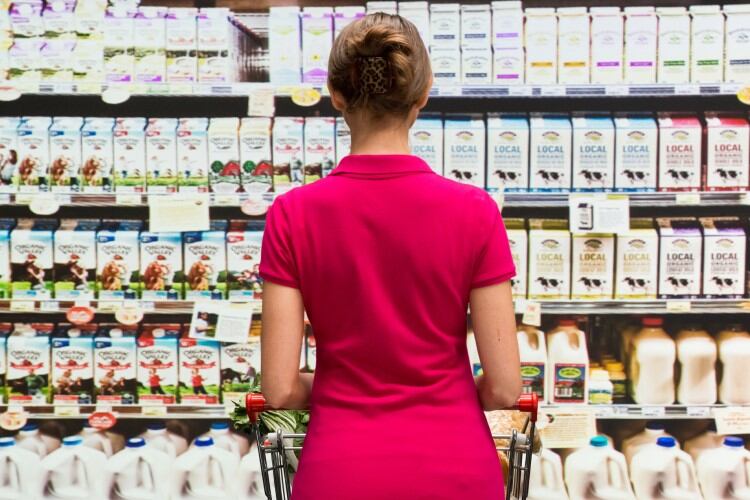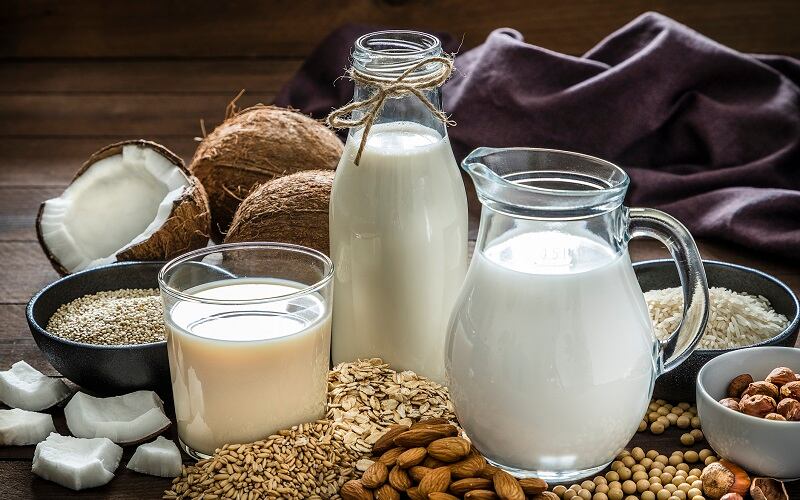According to Global Market Insights, the dairy alternatives market is projected to grow at 9% CAGR during the next decade, reaching an estimated value of $68bn in 2032, up $40.5bn from the global market’s 2023 valuation of $27.5bn.
While the sector comprises hybrid products, cell-based and precision-fermentation dairy among other categories, plant-based substitutes have been steadily gaining grown in the last few years. In the US alone, the plant-based retail market was worth $8bn in 2022, based on retail sales data from Spins and released by the Good Food Institute (GFI) and the Plant Based Foods Association. Of the $8bn total, the plant-based milk alternatives segment formed $2.8bn in dollar sales – well ahead of plant-based meat alternatives ($1.4bn).
Europe-wide, the sales of plant-based dairy saw double-digit growth between 2020 and 2022 according to a GFI report. Milks grew by 19%; spreads – by 40%, ice cream by 14% and cheese by 56%. But in 2021-2022, most product category sales slowed down to single digits, with plant-based milks recording more moderate 7% growth, ice cream – 8%, cheese – 4% and spreads 13%. Plant-based yogurt – which grew by 8% in 2020-2022 – even recorded a slight contraction, with sales declining by -0.4% during 2021-2022.
While this slowdown has been largely attributed to inflationary pressures and affordability, DairyReporter reached out to Richard Scheper, who works for RaboResearch Food & Agribusiness with a focus on the European dairy sector, to find out what’s in store for the dairy alternatives market going forward. One thing is certain, he suggests; alt dairy is here to stay. “If you walked into a supermarket five years ago, you had roughly three options – organic milk, branded products and private-label products. And if you are to walk into the same supermarket today, you might find 10 options – including alternatives, but also new concepts - for example, those that advance certain sustainability topics. That’s because there’s demand but also because liquid milk is a low-margin business and there is an incentive for the processors and the retailers to shake up the category.
“And so, alt dairy is here, it’s established, and it’s not going away. It will continue to grow, particularly the plant-based segment, but perhaps not in double-digit figures but high single-digit or low-double digits. We’d have to look at, say, mid-range single-digits.”
So what are the most important factors in this market shake-up from a consumer perspective? Scheper said: “Price is a really important factor, together with the taste and perhaps also the nutritional value. But I would say that the taste and price parity might be the most important factors for plant-based products.”
“With dairy alternatives, it’s not a black-and-white story, or alternatives versus dairy products. There are also a lot of hybrid products out there and there’s still a lot of opportunity going forward.” – Richard Scheper, Rabobank RaboResearch Food & Agribusiness
He added that even though more dairy companies are entering the alternatives market, achieving price parity remains a challenge. “In the past few years, there have been a lot of introductions - if you look at all the large dairy companies, most of them now have a plant-based alternative in their portfolio, for either liquid milk or yogurt. If you compare this against other sectors, you can see that competition has increased, a few large brand names have lowered margins per unit, which points towards a market that has become more mature. Now, it’s about which companies are able to apply economies of scale and efficiency.”
“I won’t be surprised if the market for liquid alternatives in Western Europe is close to 20% by 2033. But the main challenges remain price parity, though compared to dairy products, the gap has narrowed as inflation on dairy has been higher than on alt dairy in many countries.”
He added: “If alt dairy reaches price parity, brands and retailers might entice a larger group of consumers – particularly the hybrid consumer who would consume both dairy and alternatives. By narrowing down the price difference, the balance could shift a little.”
Beverages aside, ice cream is another category that can be exploited by alt dairy manufacturers. According to GFI, alt dairy ice cream is in a unique position to appeal to both those who are seeking indulgent foods as well as to health- and eco-conscious consumers. The category also holds the third highest rate of household penetration in the US, with one in 10 households having purchased plant-based ice cream and frozen novelties in 2022, while in Europe, plant-based ice cream unit sales grew by 15% between 2020 and 2022. Scheper says the category is clearly emerging as one to watch, with more companies introducing vegan options. “As for cream, certain milkfats are being replaced by alt fats, so there’s definitely a category emerging there,” Scheper explained.
Precision fermentation and cell-based dairy - ‘a difficult call’
Beyond the plant-based market, Scheper expects that more opportunities will crop up in the precision fermentation space. “I think plant-based is now well-established, and it will develop at more moderate pace, single-digit growth. Cell-based dairy, I am not a technical expert but having listened to a lot of experts, I am not so sure that it would lift off in terms of the volume.
“I am more interested in the precision fermentation - if that does evolve, then you also have something that’s identical in taste and nutritional value. And it’s early to say, but my assumption is that there’s more potential for scale there. But that’s a difficult call to make.”
He added: “If we ‘follow the money’, I am noticing that more investment is going towards precision fermentation, specifically proteins. For food companies, another reason why they are interested in is to do with lowering their carbon footprint, which can be achieved by replacing certain dairy ingredients with non-animal products. I think this is all still early stages, but we do see a lot of companies are investing in this direction. We could also see hybrid products, for example, plant-based products that contain dairy-identical proteins.”
Scheper explained that precision fermentation proteins are likely to remain in the more premium space until ‘we are able to move enough volume’ - for example in sports nutrition, adult nutrition, medical and infant nutrition products. Apart from price, the growth of precision fermentation dairy could also be hampered by the unpredictable economic environment investors are finding themselves in, while regulatory hurdles remain a challenge in many markets. According to Scheper, approval ‘could take years’ while capital isn’t as abundant. “Compared to three years ago, attracting capital from investors has also become more challenging, due to interest rate rises and economic volatility.”
Cheese still playing catch-up
Back to food, in terms of product categories, dairy-free cheese is an outlier, ‘a few steps behind’ in R&D from the likes of milk and yogurt alternatives, according to Scheper. “Cheese is much more complex than milk, for example,” he said, adding that in technical terms, both milk and yogurt alternatives are relatively easier to make compared to cheeses. “There are so many different cheese varieties and so many ways in which they are consumed,” he explained.
Foodservice, however, remains a key niche for cheese alternatives. “In the case of processed cheese, there have been hybrid products for quite a while, so I definitely see potential for plant-based cheese tailored for the foodservice industry, e.g. as a burger topping, because that way it becomes part of bigger dish and the taste or the nutritional value of the cheese won’t be as paramount."
“But to replace, say, parmesan, that’s a completely different story," he added. "I don’t see it happening any time soon as that involves a completely different process - you also have to mimic the whole ripening process, so there’s much more complexity to it.”
The nutritional value of cheese alternatives is still a hurdle, then. “If you look at a lot of the plant-based cheeses out there, and look at their ingredients list and Nutri-Score, there tends to be a lot of coconut oil and a lot of starch and only little protein,” Scheper said. “The quality of the protein is also another matter. In traditional dairy, there are many types of protein, but with plants, you have to make blends and these foods are generally low on protein value and they have to be more concentrated. But that’s why, if a plant-based product forms part of a bigger dish, the nutritional value argument is less strong – and same for taste.”
Overall, while the dairy alternatives market is here to stay, Scheper expects the category to remain complementary to traditional dairy. “Alternatives might take away some of dairy’s growth, but they will not wipe away or fully replace it,” he concluded. “Perhaps we will need dairy alternatives on a global scale to be able to provide enough food for everyone. Bit in terms of the sector’s development, with the more established categories like milk or yogurts, we also have to be more realistic about the growth outlook.”


